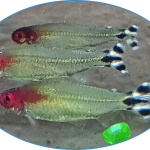Rummys are easy to keep and get along well with others
Rummy-nosed tetras in action
Rummy-nosed tetras (Hemigrammus rhodostomus) are an excellent, easy, interesting fish, particularly in a smaller aquarium setup. ‘Rummy-nosed’ obviously from their red heads – the reddish colour extends somewhat behind the head as well. Very pretty horizontally black and white stripey tails at the end of silvery bodies completes the look.
The rummys are a peaceful, community fish. They exhibit what I would call ‘social’ rather than ‘schooling’ behaviour – they will hang out generally together but don’t really exhibit tightly coordinated turns and formations. I’ve had seven rummy-nosed tetras since the Fireplace Aquarium first started – they were the first fish I ever added. The usual advice is to keep them in groups of at least 6 so they can enjoy social interactions with each other.
The rummy-nosed tetras will happily (and sometimes vigorously) go after the usual dried flake aquarium food but they are not really very picky eaters. They do not nip at other fish, nor do they attack aquarium plants. Although my tank has a covered lid so jumping is not an issue, I have never noticed them trying to jump out of the water. It would be lovely if rummy-nosed tetras ate algae, but you can’t have everything and they don’t do that, nor are they interested in dried algae wafers as catfish and amano shrimp are. If you have an algae problem, rummy-nosed tetras are not going to be a solution, although a lot of algae in their environment doesn’t seem to bother them.

Rummy-nosed tetras start small and stay small, topping out at no longer than 4 cm. There seem to be bigger vs. smaller ones in the tank and some say the bigger ones are the females, but other sources say you can’t really tell the genders apart visually. I have never seen evidence of breeding or attempted breeding. The water in the Fireplace Aquarium is slightly acidic, and very hard, and although that’s not a problem for them to live in, it might not be condusive to breeding – I’m ok with that.
I have never had any issues with aggression, either between the rummys and each other, or between the rummy-nosed tetras and any of the other aquatic inhabitants, in fact lately it seems the rummy-nosed tetras and the five-banded barbs have taken to swimming around together. They certainly all charge together to the top of the tank at feeding time, but not in any kind of fighty kind of way.
Rummy-nosed tetras change colour at night
During the day, the rummys have a very intense red head colour. At night however, they pale up significantly to a dull pink that covers substantially less of their heads. Once the lights come on in the morning, they colour back up to the normal red colour. Apparently if stressed or ill they can also lose their colour. I’ve never seen that, but as mentioned, they are quite robust and may not have been meaningfully stressed or ill.
Rummy-nosed tetras can help establish a new tank
Rummy-nosed tetras schooling after a water change
I didn’t know this at the time, but after first setting up an aquarium, the water chemistry characteristics are quite unstable and take a while to “cycle”. The cycling involves an establishment of a stable population of beneficial bacteria* in highly porous structures of the aquarium, usually the filter. In a settled stable aquarium these microbes metabolise otherwise highly toxic ammonia into the also dangerous nitrites, and subsequently into the relatively harmless nitrates. Ammonia is the primary waste product of fish, so in a non-cycled tank that is overstocked with fish, the fish can poison themselves in their own wastes.
In my experience however, the rummy-nosed tetras are incredibly robust. I set up the new tank, filled it with water and thought adding some fish would be a good idea. I picked up eight rummy-nosed tetras as the local fish store because they were small, would stay small, and looked different and pretty and just dumped them in the tank. This is NOT how you want to do this! All of the rummys instantly went into shock, got this paralysed look to them and sank to the bottom unmoving and in some cases properly upside down. You need to gradually get your new fish accustomed to the water chemistry and temperature in their new environment so “don’t do this at home” as they say.
That said, after several minutes of potentially tragic-looking drama, the tetras gradually started to perk up. One died straight away, but the other seven rallied and are still going strong today years later. The new aquarium started to go through various stages of cycling with bacterial blooms, massive algae attacks, etc, but the rummy-nosed tetras have comfortably sailed through all of it. I think part of how they were able to do this is that 7 small fish in a 40 L tank aren’t a very big metabolic load, so the modest amount of ammonia put out by the fish jump-started the bacterial metabolic process and with a reasonable weekly water change schedule never got up to toxic levels. Since the tank got established with the rummy-nosed tetras I have never been able to detect either ammonia or nitrites using test kits/strips.
*or primarily the archaea rather than bacteria according to some sources.